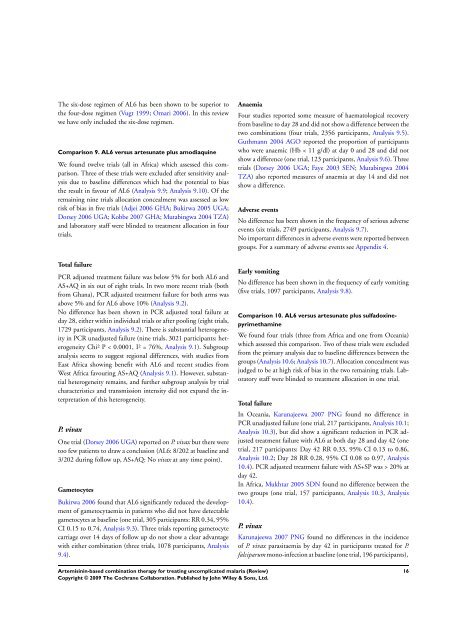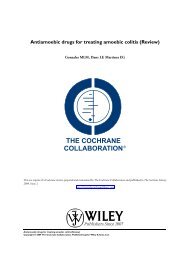Artemisinin-based combination therapy for ... - The Cochrane Library
Artemisinin-based combination therapy for ... - The Cochrane Library
Artemisinin-based combination therapy for ... - The Cochrane Library
Create successful ePaper yourself
Turn your PDF publications into a flip-book with our unique Google optimized e-Paper software.
<strong>The</strong> six-dose regimen of AL6 has been shown to be superior to<br />
the four-dose regimen (Vugt 1999; Omari 2006). In this review<br />
we have only included the six-dose regimen.<br />
Comparison 9. AL6 versus artesunate plus amodiaquine<br />
We found twelve trials (all in Africa) which assessed this comparison.<br />
Three of these trials were excluded after sensitivity analysis<br />
due to baseline differences which had the potential to bias<br />
the result in favour of AL6 (Analysis 9.9; Analysis 9.10). Of the<br />
remaining nine trials allocation concealment was assessed as low<br />
risk of bias in five trials (Adjei 2006 GHA; Bukirwa 2005 UGA;<br />
Dorsey 2006 UGA; Kobbe 2007 GHA; Mutabingwa 2004 TZA)<br />
and laboratory staff were blinded to treatment allocation in four<br />
trials.<br />
Total failure<br />
PCR adjusted treatment failure was below 5% <strong>for</strong> both AL6 and<br />
AS+AQ in six out of eight trials. In two more recent trials (both<br />
from Ghana), PCR adjusted treatment failure <strong>for</strong> both arms was<br />
above 5% and <strong>for</strong> AL6 above 10% (Analysis 9.2).<br />
No difference has been shown in PCR adjusted total failure at<br />
day 28, either within individual trials or after pooling (eight trials,<br />
1729 participants, Analysis 9.2). <strong>The</strong>re is substantial heterogeneity<br />
in PCR unadjusted failure (nine trials, 3021 participants: heterogeneity<br />
Chi² P < 0.0001, I² = 76%, Analysis 9.1). Subgroup<br />
analysis seems to suggest regional differences, with studies from<br />
East Africa showing benefit with AL6 and recent studies from<br />
West Africa favouring AS+AQ (Analysis 9.1). However, substantial<br />
heterogeneity remains, and further subgroup analysis by trial<br />
characteristics and transmission intensity did not expand the interpretation<br />
of this heterogeneity.<br />
P. vivax<br />
One trial (Dorsey 2006 UGA) reported on P. vivax but there were<br />
too few patients to draw a conclusion (AL6: 8/202 at baseline and<br />
3/202 during follow up, AS+AQ: No vivax at any time point).<br />
Gametocytes<br />
Bukirwa 2006 found that AL6 significantly reduced the development<br />
of gametocytaemia in patients who did not have detectable<br />
gametocytes at baseline (one trial, 305 participants: RR 0.34, 95%<br />
CI 0.15 to 0.74, Analysis 9.3). Three trials reporting gametocyte<br />
carriage over 14 days of follow up do not show a clear advantage<br />
with either <strong>combination</strong> (three trials, 1078 participants, Analysis<br />
9.4).<br />
Anaemia<br />
Four studies reported some measure of haematological recovery<br />
from baseline to day 28 and did not show a difference between the<br />
two <strong>combination</strong>s (four trials, 2356 participants, Analysis 9.5).<br />
Guthmann 2004 AGO reported the proportion of participants<br />
who were anaemic (Hb < 11 g/dl) at day 0 and 28 and did not<br />
show a difference (one trial, 123 participants, Analysis 9.6). Three<br />
trials (Dorsey 2006 UGA; Faye 2003 SEN; Mutabingwa 2004<br />
TZA) also reported measures of anaemia at day 14 and did not<br />
show a difference.<br />
Adverse events<br />
No difference has been shown in the frequency of serious adverse<br />
events (six trials, 2749 participants, Analysis 9.7).<br />
No important differences in adverse events were reported between<br />
groups. For a summary of adverse events see Appendix 4.<br />
Early vomiting<br />
No difference has been shown in the frequency of early vomiting<br />
(five trials, 1097 participants, Analysis 9.8).<br />
Comparison 10. AL6 versus artesunate plus sulfadoxinepyrimethamine<br />
We found four trials (three from Africa and one from Oceania)<br />
which assessed this comparison. Two of these trials were excluded<br />
from the primary analysis due to baseline differences between the<br />
groups (Analysis 10.6; Analysis 10.7). Allocation concealment was<br />
judged to be at high risk of bias in the two remaining trials. Laboratory<br />
staff were blinded to treatment allocation in one trial.<br />
Total failure<br />
In Oceania, Karunajeewa 2007 PNG found no difference in<br />
PCR unadjusted failure (one trial, 217 participants, Analysis 10.1;<br />
Analysis 10.3), but did show a significant reduction in PCR adjusted<br />
treatment failure with AL6 at both day 28 and day 42 (one<br />
trial, 217 participants: Day 42 RR 0.33, 95% CI 0.13 to 0.86,<br />
Analysis 10.2; Day 28 RR 0.28, 95% CI 0.08 to 0.97, Analysis<br />
10.4). PCR adjusted treatment failure with AS+SP was > 20% at<br />
day 42.<br />
In Africa, Mukhtar 2005 SDN found no difference between the<br />
two groups (one trial, 157 participants, Analysis 10.3, Analysis<br />
10.4).<br />
P. vivax<br />
<strong>Artemisinin</strong>-<strong>based</strong> <strong>combination</strong> <strong>therapy</strong> <strong>for</strong> treating uncomplicated malaria (Review)<br />
Copyright © 2009 <strong>The</strong> <strong>Cochrane</strong> Collaboration. Published by John Wiley & Sons, Ltd.<br />
Karunajeewa 2007 PNG found no differences in the incidence<br />
of P. vivax parasitaemia by day 42 in participants treated <strong>for</strong> P.<br />
falciparum mono-infection at baseline (one trial, 196 participants),<br />
16








